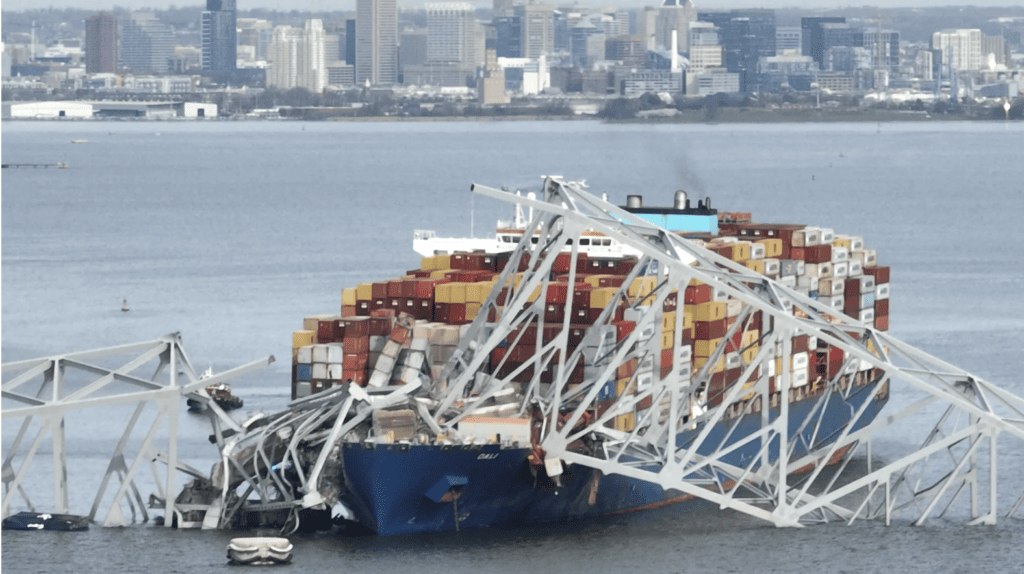Supply Chain Sector Bracing For Impact From Baltimore Bridge Collapse

As the supply chain sector grapples with the aftermath of the bridge collapse in Baltimore, experts say it is crucial to mitigate the impact on operations and minimize disruptions to the flow of goods along the U.S. East Coast.
Yesterday’s tragic collapse of the Francis Scott Key Bridge in Baltimore is sending ripple effects through the supply chain and manufacturing sectors, with immediate concerns arising over the disruption of vital logistics routes. As the primary artery to the Port of Baltimore, a crucial hub for regional and national commerce, the collapse threatens to disrupt logistics flows and livelihoods for some time.
The bridge, spanning 1.6 miles, served as a lifeline for the Port of Baltimore, facilitating the movement of goods crucial to the region’s economy. Known as the busiest U.S. seaport for autos and light trucks, in 2023, the Port of Baltimore handled 52.3 million tons of foreign cargo, valued at nearly $81 billion, including a record 847,158 cars and light trucks, as well as 1.3 million tons of roll on/roll off farm and construction machinery, according to the Maryland Port Administration. It is also a busy hub for shipments of coal, petroleum products, and sugar. In total, roughly 30 to 40 container vessels call the Port of Baltimore every week, unloading or loading some 21,000 TEU (containers).
The port is also a key economic engine for the city and the state, directly employing more than 15,000 workers and indirectly responsible for nearly 140,000 more jobs in trucking, warehousing and other related industries. It generates nearly $2.6 billion in total business income.
While President Joe Biden has pledged federal support for rebuilding efforts, supply chain and manufacturing leaders are focused on the impact from the immediate disruptions, which include the initial need to remove the vessel and the collapsed bridge from the shipping channel.
The resulting closure of the port now has logistics, transportation, supply chain, and manufacturing professionals preparing for the impact of disrupted service. With vessel traffic suspended and cargo stuck in limbo, manufacturers such as food giant McCormick & Co. and automakers General Motors and Ford are assessing operational impacts and rerouting shipments as necessary, notes Mirko Woitzik, Global Director of Intelligence for Everstream Analytics.
Cargo currently en route is being diverted to alternatives, which Woitzik reports “is expected to strain labor and handling capacities at nearby ports such as Philadelphia and Norfolk, leading to spill-over congestion and delays.”
Experts also say the incident underscores the vulnerability of global supply chains. “The disruption comes as geopolitical conflicts and natural disasters wreak havoc elsewhere. Shipping headed for the Suez Canal is being disrupted from attacks by Houthi rebels, while drought is limiting shipping through the Panama Canal. What’s more, industrial actions in some key ports, including in Australia and Finland, are adding to delays. All that is to say, it won’t take much to hobble supply chains and reinflate price pressures,” notes Harry Murphy Cruise, Economist, Moody’s Analytics.
Supply chain managers need to act quickly, adds Andrei Quinn-Barabanov, Supply Chain Industry Practice Lead at Moody’s. “The tragic Key Bridge collapse will inevitably lead to delays in deliveries that go through the I-95 corridor between Washington DC and New York or through the Port of Baltimore. Supply chain managers who get their deliveries via either of these routes need to immediately accelerate orders that are likely to be affected. Speed of action is critical.”
The silver lining, if there is one?
“Although many automotive manufacturers import parts through the Port of Baltimore, we expect that they will be able to reroute parts quickly through other ports to avoid lengthy factory line shutdowns,” say Ben Ruddell and Richard Rushforth, professors in the School of Informatics, Computing, and Cyber Systems at Northern Arizona University. And while they expect major supply chain delays due to this bridge collapse, they believe those delays “should be measured in days or weeks, not months. The abundance of alternative ports on the U.S. Atlantic provides redundancy and resilience and will expedite supply chain adaptation, limiting overall consequences from this disaster.”
